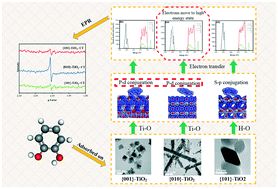Generation of environmentally persistent free radicals on faceted TiO2 in an ambient environment: roles of crystalline surface structures†
Abstract
The formation of environmentally persistent free radicals (EPFRs) is usually associated with the valence changes of transition metals. The crystalline structures of metal oxides and the role of degradation byproducts in the formation and stabilization of EPFRs have not been fully addressed. In this study, three types of anatase TiO2 with predominantly exposed {001}, {010}, and {101} facets were prepared as model crystal facet structures. Catechol (CT) was loaded onto the faceted TiO2 at room temperature, and EPFRs were only generated on {010}-TiO2 with valence unchanged. The p–d conjugation between Ti and the O from CT was a prerequisite for EPFR formation, and the presence of high-energy electrons involved in p–d conjugation was essential for EPFR stabilization based on quantum chemical calculations. The higher density of unsaturated titanium atoms and more favorable atomic arrangement for electron transfer are the reasons why only {010}-TiO2 stabilized EPFRs. The stability of EPFRs under light and dark conditions was also investigated. The intermediates from CT formed secondary EPFRs at the early stages of the photocatalytic process. Continuous illumination accelerated intermediate degradation and was accompanied by a decrease in EPFR types. This study provides an in-depth understanding of the crystalline structure and degradation byproducts involved in the formation of EPFRs.

- This article is part of the themed collection: Environmental fate of nanomaterials


 Please wait while we load your content...
Please wait while we load your content...